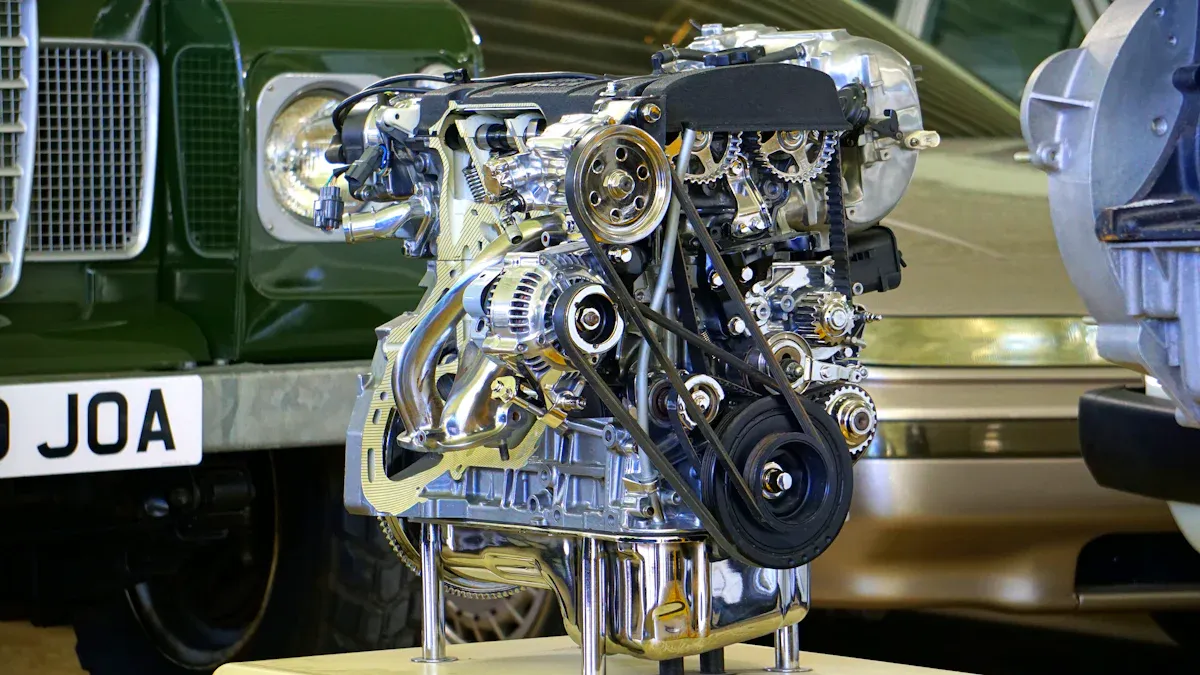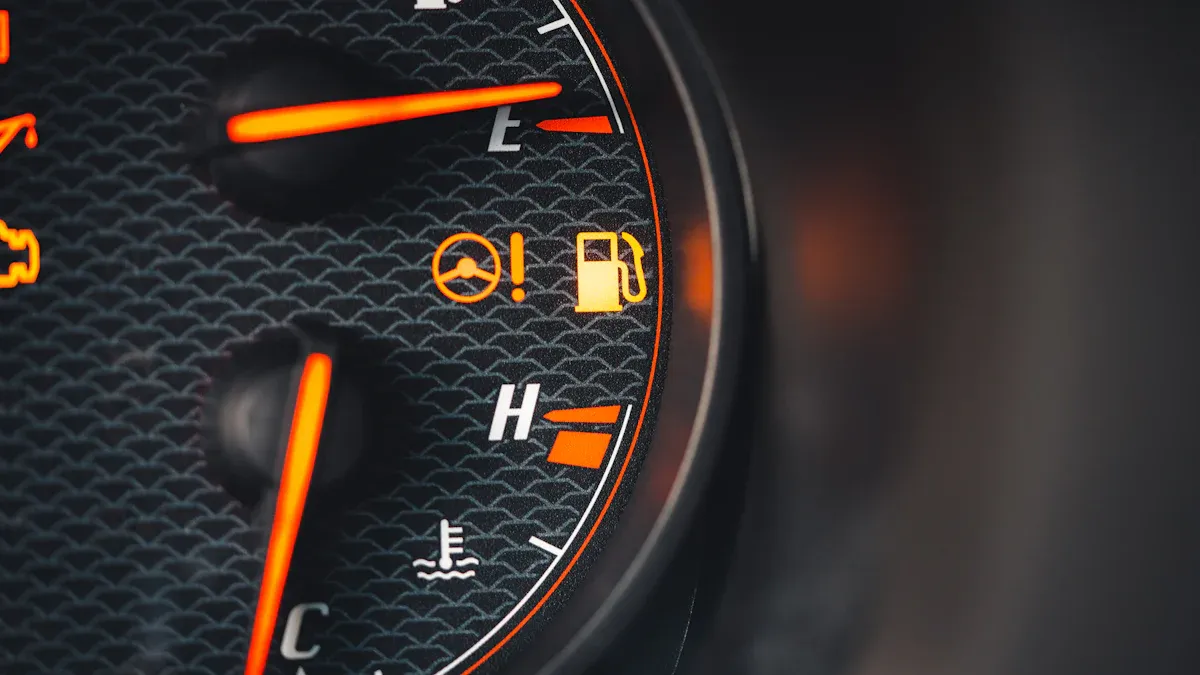
Heat-resistant materials play a vital role in solving heat-related challenges in the automotive industry. These materials protect critical components, such as engines and exhaust systems, from extreme temperatures. For example, single shell heat shields, which dominate 69.2% of the market, effectively manage heat and safeguard your vehicle’s performance. Additionally, advanced coatings and polymers enhance durability, reduce emissions, and improve fuel efficiency. As the demand for electric vehicles grows, these materials ensure safety and efficiency in thermal management systems, making them indispensable for modern automotive applications.

The engine bay is one of the hottest areas in your vehicle. Combustion engines generate heat as they burn fuel to produce energy. Friction between moving parts, such as pistons and crankshafts, also adds to the heat. In electric vehicles, battery packs and power electronics create significant heat during operation. Additionally, external factors like high ambient temperatures can further increase the heat load under the bonnet. Without proper heat management, these sources can overwhelm the system.
Excessive heat can degrade the performance of critical automotive components. For instance, prolonged exposure to high temperatures can weaken materials, causing them to warp or crack. Tests like the dry heat test (Test Bb) simulate gradual temperature increases to evaluate how non-heat-dissipating specimens perform. Heat-dissipating components undergo tests like Test Bd and Test Be to assess their reliability under real-world conditions. The shift toward electromechanical systems has made high-temperature electronics more common, but testing their reliability remains a costly and time-consuming process. Recent advancements in integrated circuit technology have improved the durability of these components, ensuring they perform better under extreme conditions.
High temperatures in the engine bay can lead to serious safety risks. Overheated components may fail, causing breakdowns or even fires. Studies using methods like the Kaplan-Meier estimator and Cox proportional hazards model have shown that vehicles with poor maintenance and high operational stress face a greater risk of early failure. For example, a fleet analysis revealed that high operational temperatures significantly increased the likelihood of transmission failure. Installing a heat shield or heat barrier can help protect sensitive parts and reduce these risks. Effective heat management not only prevents failures but also ensures your vehicle remains safe and reliable.
Ceramic materials are among the most effective solutions for managing extreme temperatures in automotive systems. These materials can withstand high heat without losing their structural integrity. For example, ultra-high-temperature ceramics (UHTCs) are used in components like exhaust manifolds and turbochargers. They provide excellent thermal stability and resist wear caused by constant exposure to heat.
A study on ceramic materials revealed their impressive performance under varying conditions. At room temperature, they demonstrated an average bending strength of 312.90 MPa. Even at 900 °C, they maintained a strength of 190.19 MPa. This makes ceramics ideal for applications where durability and heat resistance are critical.
Ceramic coatings also play a vital role in heat management. These coatings act as a heat barrier, protecting the engine bay and other under-bonnet components from excessive heat. By reflecting and dissipating heat, they improve the efficiency and longevity of automotive systems.
Metal alloys are another essential category of heat-resistant materials. These alloys combine metals like nickel, titanium, and aluminum to create materials that can endure high temperatures and mechanical stress. In the engine bay, you’ll find these alloys in pistons, cylinder heads, and turbochargers. Their ability to maintain strength under extreme conditions ensures reliable performance.
Silicone and fluorocarbon-based rubbers are often paired with metal alloys in seals and gaskets. These rubbers provide additional heat resistance and chemical stability, making them indispensable in high-temperature environments.
The growing demand for fuel-efficient vehicles has driven innovation in metal alloys. Manufacturers now produce alloys with enhanced thermal conductivity and reduced weight. This not only improves heat management but also contributes to better fuel efficiency and reduced emissions.
Advanced polymers and composites are revolutionizing automotive applications. These materials are lightweight, durable, and capable of withstanding high temperatures. For instance, reinforced rubber composites with carbon nanotubes (CNTs) have shown remarkable thermal properties. A study found that a 30% CNT concentration increased thermal conductivity by approximately 26%.
Polymers like polyimides and PEEK (polyether ether ketone) are commonly used in electric vehicle batteries and wiring insulation. They provide excellent heat resistance while maintaining flexibility and strength. This ensures the safety and efficiency of thermal management systems in electric vehicles.
Composites, which combine polymers with materials like carbon fiber or glass, offer additional benefits. They are used in heat shields and turbo blankets to protect sensitive components from heat damage. These materials not only improve heat management but also enhance the overall performance and safety of your vehicle.

Heat-resistant materials play a critical role in protecting engine components and ensuring optimal performance. The engine bay generates intense heat due to combustion and friction, which can damage sensitive parts. Heat shields act as a thermal barrier, preventing excessive heat from reaching critical areas. This not only extends the life of components but also improves fuel efficiency and passenger comfort.
For example, stainless steel, with a melting point of 1,400 to 1,550 degrees Celsius, effectively blocks radiant heat. This ensures that sensitive parts remain safe and the vehicle's integrity is preserved.
Heat barriers also prevent issues like vapor lock and melted hoses, which can lead to costly repairs. By maintaining safe operating temperatures, these materials enhance the reliability of your vehicle.
In addition, advanced materials like turbo blankets and exhaust wraps provide extra protection for high-performance engines. These materials contain heat within specific areas, improving thermal management under the bonnet.
Exhaust systems face extreme temperatures as they handle hot gases from the engine. Heat-resistant materials ensure these systems perform efficiently while maintaining durability. Components like exhaust manifolds, mufflers, and catalytic converters rely on advanced materials to withstand high heat and mechanical stress.
Innovations in materials, such as high-temperature alloys and ceramics, have significantly improved the performance of exhaust systems. Lightweight materials are now in demand to enhance fuel efficiency and vehicle performance. For instance, advanced catalysts in catalytic converters use cerium dioxide and oxides of lanthanum, europium, and zirconium. These additions enhance thermal stability and improve the neutralization of harmful emissions.
The core of most catalytic converters consists of a ceramic monolith with a honeycomb structure. Metallic foil monoliths made of Kanthal (FeCrAl) provide high heat resistance, ensuring long-lasting performance. These advancements not only reduce emissions but also contribute to the overall reliability of your vehicle.
By using heat-resistant materials, exhaust systems can handle extreme conditions while maintaining optimal performance.
Electric vehicles (EVs) require advanced thermal management systems to ensure battery safety and efficiency. Heat-resistant materials play a vital role in regulating temperatures and preventing overheating. Without proper thermal management, battery performance can degrade, leading to reduced range and potential safety risks.
Manufacturers use a variety of materials to enhance battery thermal management. Ceramic blankets provide high thermal resistance and fire protection, making them ideal for placement above cells and below lids. Mica sheets, known for their excellent dielectric performance, are used between cells and above modules.
| Material Type | Key Properties | Applications in EV Batteries |
|---|---|---|
| Ceramic Blankets | High thermal resistance, fire delay | Protection above cells and below lids |
| Mica Sheets | Excellent dielectric performance | Used between cells and above modules |
| Aerogels | Low density, high thermal insulation | Adoption by major manufacturers like GM and Toyota |
| Encapsulating Foams | Effective in cylindrical systems | Common in cylindrical battery designs |
| Phase Change Materials | Thermal regulation | Used in various battery designs |
Aerogels, with their low density and high thermal insulation, have been adopted by major manufacturers like GM and Toyota. Encapsulating foams and phase change materials also contribute to effective thermal regulation in different battery designs. These innovations ensure that EV batteries remain safe and efficient, even under demanding conditions.
By incorporating heat-resistant materials, EVs achieve better thermal management, enhancing both performance and safety.
Heat-resistant materials significantly improve the durability of automotive components. These materials withstand extreme temperatures without degrading, ensuring your vehicle performs reliably over time. For example, an exhaust wrap protects sensitive parts from heat damage, reducing wear and tear. This extends the component longevity of critical systems like the engine bay and exhaust systems.
Using advanced materials like turbo blankets and ceramic coatings also enhances protection against thermal stress. These solutions act as a heat barrier, preventing overheating and maintaining the structural integrity of parts. By investing in heat-resistant materials, you ensure your vehicle remains durable and functional for years to come.
Heat management plays a crucial role in optimizing your vehicle's efficiency. Excessive heat can reduce the performance of high-performance engines, leading to lower fuel economy and increased emissions. Materials like exhaust wraps and turbo blankets help contain and redirect heat, improving thermal management.
For instance, an exhaust wrap minimizes heat loss in the exhaust system, allowing gases to flow more efficiently. This boosts engine performance and reduces energy waste. Similarly, a turbo blanket keeps the turbocharger at optimal operating temperatures, enhancing its efficiency. These materials not only improve performance but also contribute to better fuel efficiency and reduced environmental impact.
Safety is a top priority in automotive design, and heat-resistant materials play a vital role in ensuring it. Overheating can cause components to fail, leading to dangerous situations like engine fires. By using materials that provide effective heat management, you reduce these risks and enhance the reliability of your vehicle.
Heat barriers, such as exhaust wraps and turbo blankets, offer excellent protection against high temperatures. They shield sensitive parts from heat damage, ensuring your vehicle operates safely under extreme conditions. Additionally, these materials improve thermal management in electric vehicles, preventing battery overheating and ensuring passenger safety.
Tip: Regularly inspect and maintain heat-resistant components like exhaust wraps to maximize their effectiveness and ensure long-term safety.
Heat-resistant materials are essential for addressing automotive heat challenges. They protect components from extreme temperatures, ensuring your vehicle performs reliably and safely. These materials improve durability by resisting wear and thermal stress, enhancing the lifespan of critical systems.
Their contributions to efficiency and performance are equally significant. For instance, nanoparticles in advanced coatings increase thermal conductivity by 12%, while stress rates of 3.60 N/mm² ensure structural integrity under pressure.
| Metric | Value |
|---|---|
| Improvement with nanoparticles | 12% |
| Velocity | 1.61 m/s |
| Pressure volume | 2.44 MPa |
| Stress rate | 3.60 N/mm² |
By advancing automotive technology, heat-resistant materials pave the way for safer, more efficient vehicles. Their innovative applications continue to shape the future of transportation.
Self-adhesive heat shields are materials with a sticky backing that you can easily apply to surfaces. They act as a thermal barrier, reflecting and dissipating heat. These shields protect components in the engine compartment from high temperatures, improving their performance and longevity.
High-temperature adhesives bond materials that face extreme heat. They ensure that components like heat shields and exhaust wraps stay securely in place. These adhesives maintain their strength under high temperatures, enhancing the durability and reliability of automotive systems.
Heat-resistant materials regulate battery temperatures by dissipating excess heat. They prevent overheating, ensuring the safety and efficiency of electric vehicle batteries. Materials like ceramic blankets and mica sheets enhance battery thermal management, extending the lifespan of these critical components.
Yes, heat-resistant materials improve the efficiency of high-performance engines by managing heat effectively. For example, turbo blankets and exhaust wraps contain heat, optimizing engine performance. This reduces energy loss, improves fuel efficiency, and ensures the engine operates at peak performance.
Heat-resistant materials protect components from thermal stress and damage. By acting as a thermal barrier, they prevent overheating and wear. This extends the component longevity of critical systems like the engine compartment and exhaust systems, ensuring your vehicle remains reliable over time.